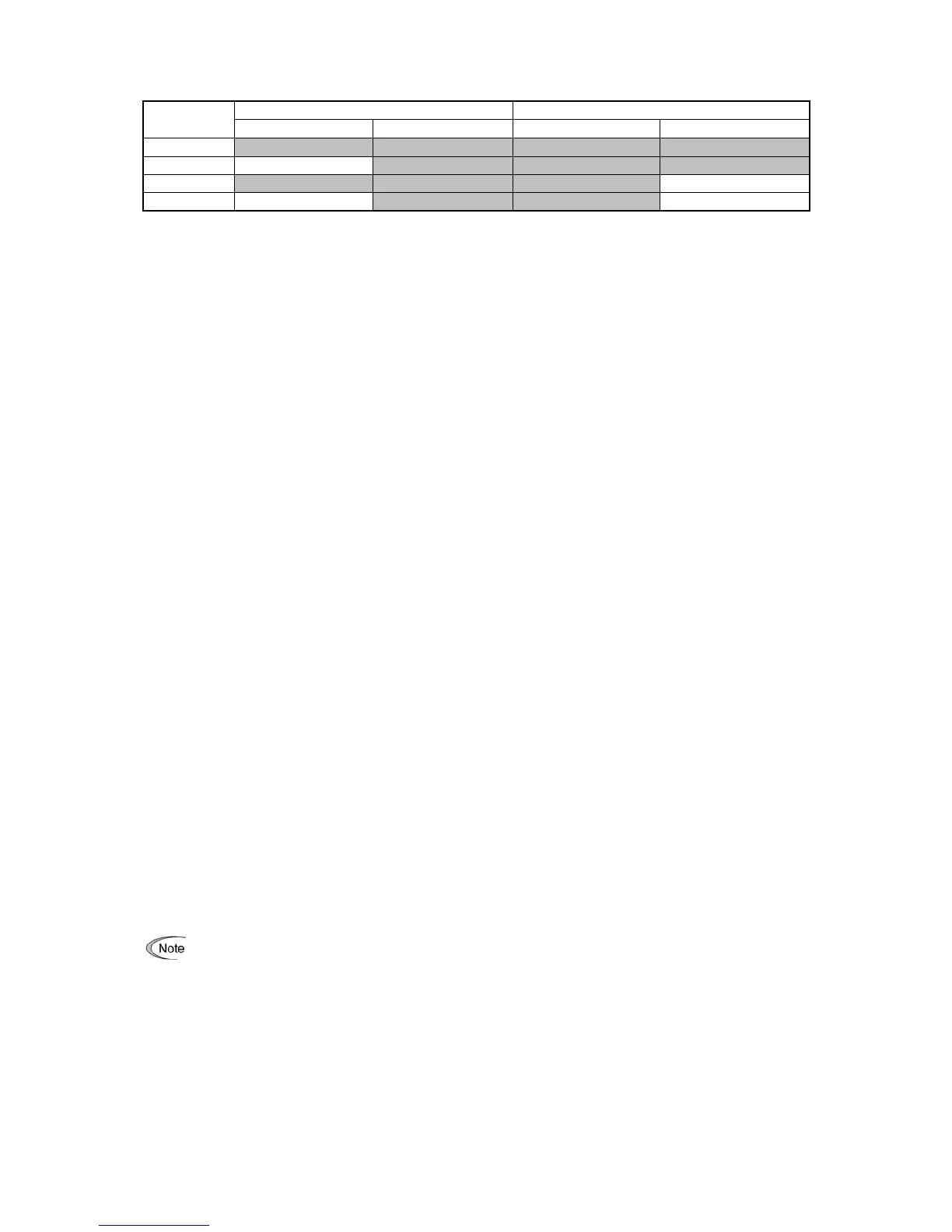4-4
H68
*
enables or disables the slip compensation function according to the motor driving conditions.
Motor driving conditions Motor driving frequency zone
H68* data
Accl/Decel Constant speed
Base frequency or below Above the base frequency
0 Enable Enable Enable Enable
1 Disable Enable Enable Enable
2 Enable Enable Enable Disable
3 Disable Enable Enable Disable
Dynamic torque vector control
To get the maximal torque out of a motor, this control calculates the motor torque for the load applied and uses it to optimize the
voltage and current vector output.
Selecting this control automatically enables the auto torque boost and slip compensation function.
This control is effective for improving the system response to external disturbances such as load fluctuations, and the motor
speed control accuracy.
Note that the inverter may not respond to a rapid load fluctuation since this control is an open-loop V/f control that does not
perform the current control, unlike the vector control. The advantages of this control include larger maximum torque per output
current than that the vector control.
V/f control with speed sensor
Applying any load to an induction motor causes a rotational slip due to the motor characteristics, decreasing the motor rotation.
Under V/f control with speed sensor, the inverter detects the motor rotation using the encoder mounted on the motor shaft and
compensates for the decrease in slip frequency by the PI control to match the motor rotation with the commanded speed. This
improves the motor speed control accuracy.
Dynamic torque vector control with speed sensor
The difference from the "V/f control with speed sensor" stated above is to calculate the motor torque for the load applied and
use it to optimize the voltage and current vector output for getting the maximal torque out of a motor.
This control is effective for improving the system response to external disturbances such as load fluctuations, and the motor
speed control accuracy.
Vector control without speed sensor
This control estimates the motor speed based on the inverter's output voltage and current to use the estimated speed for speed
control. In addition, it decomposes the motor drive current into the exciting and torque current components, and controls each
of those components in vector. No PG (pulse generator) interface card is required. It is possible to obtain the desired response
by adjusting the control constants (PI constants) using the speed regulator (PI controller).
Since this control controls the motor current, it is necessary to secure some voltage margin between the voltage that the inverter
can output and the induced voltage of the motor, by keeping the former lower than the latter.
Although the voltage of the general-purpose motor has usually been adjusted to match the commercial power, keeping the
motor terminal voltage low is necessary in order to secure the voltage margin. If the motor is driven under this control with the
motor terminal voltage being kept low, however, the rated torque cannot be obtained even when the rated current originally
specified for the motor is applied. To secure the rated torque, therefore, it is necessary to use a motor with higher rated current.
(This also applies to the vector control with speed sensor.)
This control is not available for MD-mode inverters, so do not set F42 data to "5" for those inverters.
Vector control with speed sensor
This control requires an optional PG (pulse generator) and an optional PG interface card to be mounted on a motor shaft and an
inverter, respectively. The inverter detects the motor's rotational position and speed from PG feedback signals and uses them for
speed control. In addition, it decomposes the motor drive current into the exciting and torque current components, and controls
each of components in vector.
The desired response can be obtained by adjusting the control constants (PI constants) and using the speed regulator (PI
controller). This control enables the speed control with higher accuracy and quicker response than the vector control without
speed sensor.
(A recommended motor for this control is a Fuji VG motor exclusively designed for vector control.)
Since slip compensation, dynamic torque vector control, and vector control with/without speed sensor use motor
parameters, the following conditions should be satisfied; otherwise, full control performance may not be obtained.
• A single motor should be controlled per inverter.
• Motor parameters P02*, P03*, P06* to P23*, P55* and P56* should be properly configured or auto-tuning (P04*)
should be performed.
(A Fuji VG motor requires no auto-tuning, just requires selecting a Fuji VG motor with function code (P99* = 2).
• The capacity of the motor to be controlled should be two or more ranks lower than that of the inverter under the
dynamic torque vector control; it should be the same as that of the inverter under the vector control with/without
speed sensor. Otherwise, the inverter may not control the motor due to decrease of the current detection
resolution.
• The wiring distance between the inverter and motor should be 50 m or less. If it is longer, the inverter may not
control the motor due to leakage current flowing through stray capacitance to the ground or between wires.
Especially, small capacity inverters whose rated current is also small may be unable to control the motor correctly
even when the wiring is less than 50 m. In that case, make the wiring length as short as possible or use a wire with
small stray capacitance (e.g., loosely-bundled cable) to minimize the stray capacitance.

